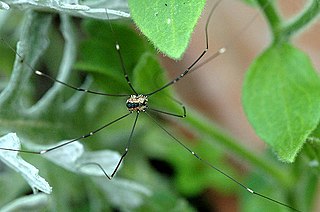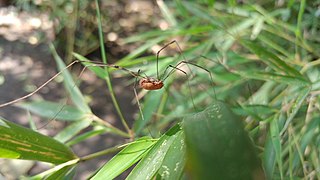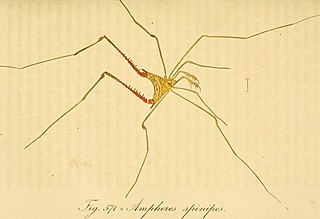
Pachylinae is the most diverse subfamily of the harvestman family Gonyleptidae, including around 400 valid species. Major groups of species occur in the Brazilian Atlantic forest, Bolivian/Peruvian highlands, Argentina, and Chilean temperate forest.

The Sclerosomatidae are a family of harvestmen with about 1,300 known species. One former subfamily has been recently removed to form a new family, Globipedidae.

Leiobunum is a genus of the harvestman family Sclerosomatidae with more than 100 described species. Contrary to popular belief, they are not spiders, although they share a resemblance. They are arachnids, in the order Opiliones, harvestmen. Species in Leiobunum tend to have relatively long legs compared with other harvestmen, and some species are gregarious.
The Stygnidae are a family of neotropical harvestmen within the suborder Laniatores.
The Manaosbiidae are a family of neotropical harvestmen within the suborder Laniatores.
Kimulidae is a small neotropical family of the harvestman infraorder Grassatores with about thirty described species.
Geaya is a genus of harvestmen in the family Sclerosomatidae from Latin America.
Paratamboicus was a genus of harvestmen in the family Sclerosomatidae from the Americas, described by Mello-Leitão 1940 with the type-species by original designation being Paratamboicus bicornutus Mello-Leitão, 1940. It was much later considered as Junior subjective synonym of Holcobunus Roewer 1910 by Tourinho & Kury (2001).
Onostemma is a genus of harvestmen in the family Sclerosomatidae from Brazil.

Prionostemma is a large genus of harvestmen in the family Sclerosomatidae from Mexico, Central America, and South America.
Amauropilio is an extinct genus of harvestmen in the family Sclerosomatidae. It is known from the Chadronian aged Florissant Formation in Colorado.
Abaetetuba is a genus of harvestmen in the family Sclerosomatidae.
Caelopyginae is a neotropical sub-family of harvestmen in the family Gonyleptidae.
Taito is a genus of harvestmen in the family Cosmetidae. The genus is endemic to the Amazon Basin in Brazil, Colombia, Ecuador and Peru.

Ampheres is a genus of neotropical harvestmen
Holcobunus is a genus of the order Opiliones in the family Sclerosomatidae. The genus was first described by Roewer, 1910
Garleppa is a genus of the order Opiliones in the family Sclerosomatidae. The genus was first described by Roewer, 1912
Bourguyia is a genus of harvestmen in the family Gonyleptidae with four described species. All species are found in Brazil.





